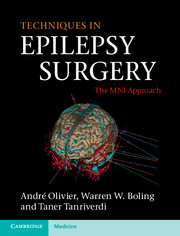Book contents
- Frontmatter
- Contents
- Acknowledgment
- Preface
- 1 History of epilepsy surgery
- 2 The search for the epileptic focus: investigation of the surgical candidate
- 3 Surgical anatomy
- 4 Neuronavigation and preoperative brain mapping
- 5 Stereoelectroencephalography (stereotactic intracranial recording)
- 6 Anesthesia and awake procedure
- 7 Peroperative brain mapping
- 8 Endopial resection (intervascular endopial gyral emptying)
- 9 Surgery of temporal lobe epilepsy: cortico-amygdalohippocampectomy
- 10 Surgery of temporal lobe epilepsy: transcortical selective amygdalohippocampectomy
- 11 Surgery of central area epilepsy
- 12 Surgery of frontal lobe epilepsy
- 13 Surgery of parietal lobe epilepsy
- 14 Surgery of insular lobe epilepsy
- 15 Surgery of occipital lobe epilepsy
- 16 Hemispherectomy
- 17 Callosotomy
- 18 Epilepsy and brain tumors
- 19 Surgical treatment of cortical dysplasias
- 20 Reoperations in failed epilepsy surgery
- 21 Alternative procedures in surgery for epilepsy
- 22 Complications of epilepsy surgery
- 23 Quality of life after epilepsy surgery
- Index
- References
9 - Surgery of temporal lobe epilepsy: cortico-amygdalohippocampectomy
Published online by Cambridge University Press: 05 October 2012
- Frontmatter
- Contents
- Acknowledgment
- Preface
- 1 History of epilepsy surgery
- 2 The search for the epileptic focus: investigation of the surgical candidate
- 3 Surgical anatomy
- 4 Neuronavigation and preoperative brain mapping
- 5 Stereoelectroencephalography (stereotactic intracranial recording)
- 6 Anesthesia and awake procedure
- 7 Peroperative brain mapping
- 8 Endopial resection (intervascular endopial gyral emptying)
- 9 Surgery of temporal lobe epilepsy: cortico-amygdalohippocampectomy
- 10 Surgery of temporal lobe epilepsy: transcortical selective amygdalohippocampectomy
- 11 Surgery of central area epilepsy
- 12 Surgery of frontal lobe epilepsy
- 13 Surgery of parietal lobe epilepsy
- 14 Surgery of insular lobe epilepsy
- 15 Surgery of occipital lobe epilepsy
- 16 Hemispherectomy
- 17 Callosotomy
- 18 Epilepsy and brain tumors
- 19 Surgical treatment of cortical dysplasias
- 20 Reoperations in failed epilepsy surgery
- 21 Alternative procedures in surgery for epilepsy
- 22 Complications of epilepsy surgery
- 23 Quality of life after epilepsy surgery
- Index
- References
Summary
Introduction
Epilepsy arising from the temporal lobe can be divided into two main types, lateral neocortical and mesial temporal lobe epilepsy (MTLE), based on the location of the seizure focus. In lateral epilepsy, the seizure focus is localized to the six-layered cortex of the temporal lobe found lateral to the collateral fissure. Several studies have attempted to identify features of the seizure pattern or history that can distinguish between these two types of epilepsy, but they share too many features to make a clear distinction in a single patient. In general, MTLE more commonly displays the typical temporal lobe seizure elements of an epigastric or cephalic aura, loss of awareness, automatisms, posturing, and postictal amnesia. Lateral temporal epilepsy often manifests signs related to perisylvian structures such as an auditory hallucination or postictal aphasia, in the dominant hemisphere. It should be suspected when a temporal seizure pattern is present without mesial temporal sclerosis. MTLE is more related to childhood febrile convulsions and its structural sequela, mesial temporal sclerosis. In a series of 878 patients operated on for temporal lobe epilepsy at the MNI (1928–1973), discrete focal lesions were identified in the lateral cortex of 202. More recent surgical series have identified even more lateral cortical lesions in temporal lobe epilepsy representing an increased recognition of dysplasia and benign tumors on preoperative imaging.
The two main modalities of temporal lobe surgery are the cortico-amygdalohippocampectomy (CAH) and the selective amygdalohippocampectomy (SelAH). These will be discussed separately. In this chapter we will address the surgical anatomy of the temporal lobe as well as describe the technique of CAH. In Chapter 10 the SelAH will be described in detail.
- Type
- Chapter
- Information
- Techniques in Epilepsy SurgeryThe MNI Approach, pp. 97 - 114Publisher: Cambridge University PressPrint publication year: 2012
References
- 2
- Cited by



